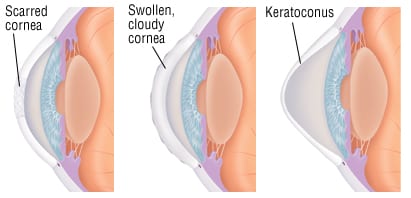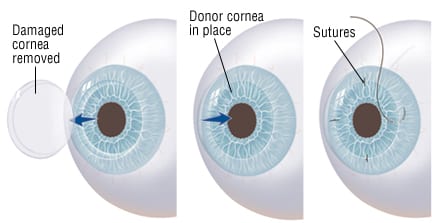Patient Basics: Corneal Transplant
Originally published by Harvard Health.
What Is It?
The cornea is the clear, round, “window” of tissue that allows light to enter the front of the eye. If the cornea becomes severely diseased or damaged, it can distort or even block the normal path of light into the eye. When this happens, light does not focus normally on the retina, the layer at the back of the eye that is responsible for sight. As a result, there can be a significant loss of vision in the affected eye.
When corneal conditions cause serious, irreversible vision problems, a corneal transplant often is the best solution. In a corneal transplant, an eye surgeon first removes the diseased or damaged area of cornea. The removed tissue then is replaced by a section of healthy cornea that has been taken from the eye of a dead donor.
Donor corneas come from a local eye bank that has been certified by the Eye Bank Association of America. The role of the local eye bank is to locate donor corneas and to distribute them to eye patients registered on a transplant waiting list. In most cases, the waiting time for a suitable cornea is fairly brief, often a matter of days. Usually, you can have the transplant done as an outpatient.
Corneal transplantation is the most common type of transplant surgery done in the United States. More than 46,000 corneas are transplanted each year in the United States, where the procedure has a very high success rate.
What It’s Used For
Corneal transplants are used to treat persistent corneal infections, diseases that cloud the cornea (corneal dystrophies), traumatic corneal injuries and corneal scars that cannot be corrected by other therapies. Some examples include:
- Bullous keratopathy, a progressive swelling and blistering of the cornea
- Keratoconus, an eye disorder in which the middle of the cornea thins and eventually bulges outward
- Severe corneal ulcers caused by bacterial, fungal, parasitic or viral eye infections
- Severe traumatic injuries that pierce or cut the cornea
- Chemical burns of the eye
- Corneal scars
- Fuch’s endothelial dystrophy, a progressive eye disease that causes swelling, cloudiness and blistering of the cornea
- Failure or rejection of a previous corneal transplant
Preparation
If you have any uncontrolled eye problems that might threaten the success of your transplant, your doctor will treat them before surgery. You also will need a basic medical evaluation to confirm that you are healthy enough to have the transplant procedure.
As part of your preparation for surgery, your doctor will ask you about any medications you are taking, including over-the-counter medications and natural or herbal remedies. Your doctor may ask you to decrease or discontinue certain drugs before surgery. This is because some medicines can increase the risk of bleeding or other surgical complications.
As you are preparing for surgery, your local eye bank will process and evaluate the donor cornea. The eye bank must confirm that the donor cornea is free of dangerous viral infections, such as HIV and hepatitis. The donor cornea also must be transparent and structurally sound.
How It’s Done
Your doctor will give you instructions about when to stop eating and drinking before surgery. He or she also may prescribe antibiotic eye drops to be used before the surgery.
When it is time for surgery, an intravenous (IV) line will be placed into a vein in your arm to deliver fluids and medications. You will be given a sedative intravenously and local anesthesia (medicine to numb your eye and the surrounding area). Your doctor and nurse will make sure you are comfortable and pain free during the procedure. Also, the surgical team will use special techniques to keep your eyes open so you don’t have to worry about blinking.
Since a corneal transplant is a very delicate, precise form of surgery, it must be done with a special surgical microscope. The eye surgeon first will measure your eye to determine the size of the cornea that is needed. He or she will cut the donor cornea to the right size. The surgeon will remove the diseased or damaged part of your cornea using a special instrument called a trephine. A trephine cuts out a circular “button” of tissue from your cornea. Then the donor cornea will be stitched into place using fine nylon sutures (surgical threads). These sutures are much thinner than a human hair.
Once your transplant is in place, the surgeon will use an instrument called a keratoscope to project a circular image on your new cornea. Depending on the appearance of this image, the surgeon may adjust the tightness of the sutures to make sure you will be able to see clearly.
When the transplant procedure is finished, your eye will be covered with a soft eye patch and hard eye shield. You will be taken to a recovery room, where hospital personnel will monitor your condition. Once you have recovered enough to return home, you will be allowed to leave. However, someone must be available to drive you home because it is unsafe for you to drive.
Follow-Up
After your transplant surgery, you must be careful not to touch or press your eye. In most cases, you can relieve any discomfort with over-the-counter pain pills.
Usually, your first follow-up visit will be scheduled for the day after surgery. At this visit, the doctor will remove the eye patch and check your new cornea. He or she also will prescribe special steroid eye drops to help prevent your body from rejecting the transplanted tissue. At the end of this visit, the doctor will either leave the eye patch off or ask you to wear it a little while longer. The eye patch will remain in place for one to four days after surgery.
In general, you can expect to have several follow-up visits during the first two weeks after surgery. Once it is clear that your eye is healing as expected, your doctor will schedule follow-up visits at longer and longer intervals. Usually, sutures are left in place for several months before they are removed. In some cases, they are allowed to remain in the eye permanently.
As your eye heals, you will need to protect it from impact, even while you are sleeping. You can do this by wearing special eyeglasses during the day and by using an eye shield at night.
Risks
Although most corneal transplants are successful, the risks of the transplant procedure include bleeding, infection, broken sutures and side effects from anesthesia. In addition, since transplantation opens the front of the eye, there is some danger that eye fluid may start to leak out of the eye after surgery. There is also a risk that fluid pressure inside the eye will become abnormally high or low, or that the retina may detach (separate from the back of the eye). All of these problems are rare.
The most common complication of corneal transplantation is rejection of the new cornea. This is called graft rejection. In graft rejection, the body’s immune system identifies the donor cornea as a “foreign” tissue and begins to attack it. In the United States, graft rejection occurs in about 20% of corneal transplants. In most cases, it can be treated successfully with medication.
Overall, more than 90% of corneal transplants are successful. Most people find that their vision improves significantly following a corneal transplant, although many people have a degree of astigmatism, an uneven contour of the cornea that can cause some vision problems such as blurriness. After a transplant, vision improves gradually over a period of months.
When To Call a Professional
Call your doctor immediately if you develop any of the following symptoms after a corneal transplant:
- Pain or increased discomfort in the eye that received the transplant
- Increased redness of the eye
- Unusual sensitivity to light
- Decreased vision
- Flashing lights or “floaters” (semitransparent floating shapes) in your field of vision
Additional Info
National Eye Institute
2020 Vision Place
Bethesda, MD 20892-3655
Phone: 301-496-5248
http://www.nei.nih.gov/
American Optometric Association
243 North Lindbergh Blvd.
St. Louis, MO 63141
Phone: 314-991-4100
Toll-Free: 1-800-365-2219
Fax: 314-991-4101
http://www.aoa.org/
Eye Bank Association of America
1015 18th St. NW
Suite 1010
Washington, DC 20036
Phone: 202-775-4999
Fax: 202-429-6036
http://www.restoresight.org/
National Keratoconus Foundation
6222 Wilshire Blvd.
Suite 260
Los Angeles, CA 90048
Toll-Free: 1-800-521-2524
http://www.nkcf.org/





